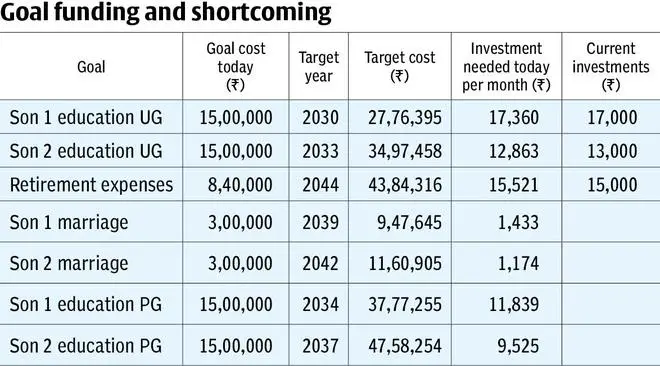

Prakash, aged 38, was keen to explore if he could afford to buy a second house. If yes, he wanted to find out the impact of the decision on his other goals.
Prakash works in a pharma company and his wife, aged 36, is a home-maker. He wanted to use the second house as his retirement home.
His cash flow: Post-tax monthly income of ₹1.8 lakh; rental income - ₹15,000 per month; his monthly expenses adjusted for school and other expenses - ₹1.05 lakh; savings - ₹45,000 per month towards his children’s education, retirement, and other goals. His outstanding housing loan was ₹28 lakh, where the EMI was ₹40,000.
He had recently changed his employment and moved from his own house to rental property with a monthly rent of ₹30,000. He wanted to know whether he could afford buying a house in the same locality. He was willing to commit ₹60,000per month as EMI. His plan was to reduce monthly savings by ₹30,000 and redirect the current rental outgo of ₹30,000 as EMI.
The price of the house that he had considered was ₹85 lakh inclusive of all registration and interior costs. His banker informed him that he could get 80 per cent of the cost of the property as loan — ₹68 lakh. At the prevailing rate of 7.25 per cent per annum, for a tenure of 15 years, his EMI would be ₹62,000. Considering the rate hike environment, a scenario analysis was also presented to him. If interest rate moved from 7.25 per cent to 9 per cent, he would have to extend his tenure to 20 years to maintain the EMI at ₹62,000. We also highlighted the likely change in his lifestyle and related expenses over the next few years.
After using savings and investments of ₹20 lakh towards the loan down payment, his liquid cash/financial assets would get reduced to ₹3 lakh. With increase in EMI, he wouldn’t be able to increase his emergency fund. This was found to be impractical for the subsequent two-three years. Besides, there would also be periods of no rental income, as this depends on occupancy of the property, which could affect his cash flows.

His current housing loan of ₹28 lakh had a balance tenure of 7.5 years. So, for the next seven-eight years, he would not be able to fund his other goals if he opted for second housing loan. He had a key goal approaching, his first son’s education in the next seven-eight years. He needed to have financial assets to support his son’s education. By way of continuing ₹15,000 per month investment towards his child’s education, he would be able to accumulate ₹30-34 lakh in the next 8-10 years. This would be insufficient to fund college education for both kids.
As shown in the table, his current investments can easily fund his sons’ education goal and retirement. But if he diverted ₹17 lakh towards second-home purchase, his retirement goal would get affected. It might be difficult to fund his other goals as he depends on his future income to service two housing loans. He believed he could sell his second home at the time of retirement which might fetch ₹4.6 crore at a conservative growth rate of 8 per cent over 22 years. We agreed with that scenario, but highlighted that before retirement, he may need to fund all his other goals as shown. With single income, he might need to run the family with a restricted budget for seven-eight years and lacked other resources to fund his goals.
On the asset allocation front, the second house would increase his allocation towards real estate and the liquidity of his assets would be limited. Taking into account these inputs, he was advised to avoid buying a second house now. He might consider it later, based on his financial position.
The writer, Co-founder of Chamomile Investment Consultants in Chennai, is an investment advisor registered with SEBI
Published on July 12, 2022

Comments
Comments have to be in English, and in full sentences. They cannot be abusive or personal. Please abide by our community guidelines for posting your comments.
We have migrated to a new commenting platform. If you are already a registered user of TheHindu Businessline and logged in, you may continue to engage with our articles. If you do not have an account please register and login to post comments. Users can access their older comments by logging into their accounts on Vuukle.